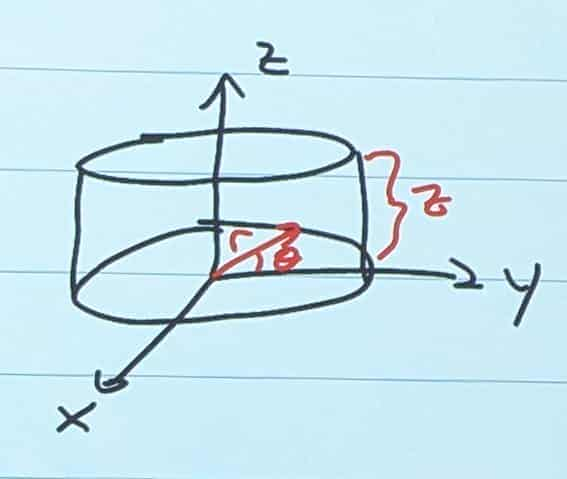Polar Coordinates

x = rcosθ y = rsinθ
- Polar Coordinates are another way of representing graph systems
- How to we apply polar coordinates to what we have been doing with double and triple integrals?
- There is a proof for this, but this is what we feed into our double and triple integrals for polar coordinates!
- You can use polar coordinates for functions that are not nice with regular coordinates.
- A classic example of such would be x2 + y2 = 1
Polar Coordinates for Double Integrals
Step One: Convert from f(x,y) to g(r, θ)
Step Two: Convert dx/dy to dArθ - Tip for this, it will ALWAYS be rdrdθ
Step Three: Convert limits (Plug in and work out) - This can be a bit tricky.
Step Four: Now, integrate as normal. U-Sub may be needed
Polar Coordinates for Triple Integrals
Now, we are dealing with cylindrical coordinates! (Polar in 3D)
x = rcosθ y = rsinθ z = z
dVol ⇛ dxdydz ⇛ rdrdθdz

- Volume = ∫∫∫dVol
Spherical Coordinates (Globe)
x = rcosθsinϕ y = rsinθsinϕ z = rcosϕ
r2 = x2 + y2 +z2
- With Spherical Coordinates, you are going to have an R like usual
- However, you are going to have TWO angles
- A polar angle along X and Y, and an azimuthal angle along Z
- The regular angle can stretch from 0 < θ < 2π
- The azimuthal angle can stretch from 0 < ϕ < π
- It is not necessary for the full 2π, as you would be double accounting for each position

- Remember with U-sub, you can either change your limits in terms of U, or sub in for you after the integration with the original limits
END OF TEST 2 MATERIAL
Vector Spaces
-
A vector spaces is a set of vectors
-
Addition and Scalar multiplication can be used!
-
Vector spaces can be anything, vectors, polynomials, functions
-
If I have two polynomials of the first degree ,
u = x + 1andv = 2x - 3, they both share the same vector space, because they are same degree -
If I add the polynomials
u = x + 1andv = 2x - 3together, I getuv = 3x - 2 -
The resulting
uv = 3x - 2is also a polynomial of degree one, so we’re still in that original vector space! -
The same is true if I multiplied
u = x + 1by 5. I would get5u = 5x +5.5uis still a polynomial of degree one, so we’re still in that first degree polynomial space!
—
- The same is true of I have the two matrices
and
- If I add and
v̂, I getû + v̂
- This results in a 2D vector, meaning that we are staying in the same 2D vector space.
5ûwould result in the same thing, another 2D vector. We’re good here.
—
These are known as the properties of closure.
-
Given
ûεV (ûis a vector in the vector space V) and scalarC, thenCûε V (The multiplied scalar will also be in vector space V) -
Given
ûεV andv̂εV , thenû + v̂ϵ V (The new added vector is also in vector space V!)
The dimension of the vector is usually noted by ℝn. The amount of non zero rows in a vector will give you that.
—
What are Axioms? What are the 8 Axioms?
Axioms are a bunch of rules which hold true inside of a vector space. There are 10 of which hold true in any vector space V
With vectors û, v̂ and ŵ, and scalars a and b
Addition
-
û + v̂=v̂ + ûThis is known as the commutative property of addition! -
û + (v̂ + ŵ)=(û + v̂) + ŵThis is known as the associative property -
û + 0 = û + 0There is a zero vector. This is known as the additive identity -
û + û'For every vector in a vector space, there is another vector that can bring it back to zero. This property is known as the additive inverse! Multiplication -
For ûϵ**V*
1û = uFor every single vector in the vector space V, 1* û will equal û. This is known as the multiplicative identity -
a * (bu) = (ab) * uThis property does not seem to have a name, but is used to combine scalars. Scalars can be combined as such. -
(a + b)u = au + buThis is known as distributivity of scalar multiplication with respect to field addition. Vectors can distribute like this! -
a(u+v) = au + avThis is known as distributivity of scalar multiplication with respect to vector addition. Just like the last property, this works as well!